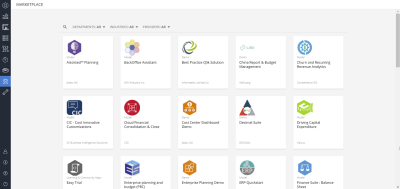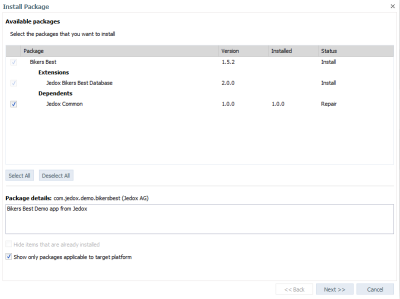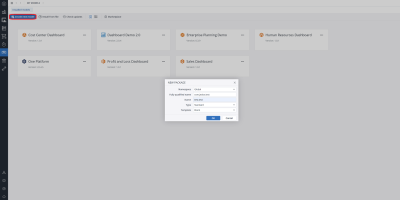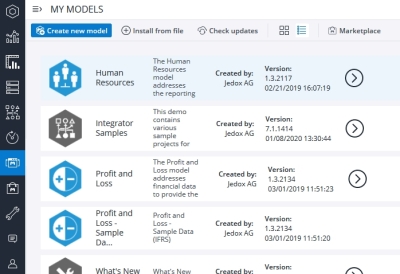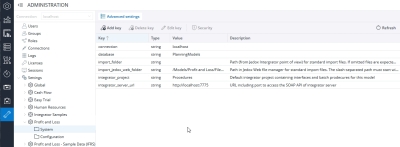Models are predefined applications comprising files/reports, OLAP databases, Integrator jobs, scheduled tasks, and settings. Not every model must contain all objects mentioned above. A model designer creates models. The models are then shipped in a so-called package to the end-user, who can configure and customize them. The shipping can happen via the Marketplace (a panel in Jedox Web, which shows content from a centralized server). A model can also be installed directly from a .jdxp file, the format used for models in Jedox. The user can see and change installed models on the My Models start page on Jedox Web.
1. Models Installation
You can install Models from the Marketplace or.jdxp files. Models can be installed multiple times in parallel using namespaces. Namespaces behave similarly to "installation directories". When installing a model several times in various namespaces, most model contents will be unique and can be modified independently. This enables you to update each model separately. The exception is the database created during the installation (if a database is being created). By default, the model always uses the same name for the database it creates. However, if the installation permits the setting of a customized database name, you can choose a different name in each separate model installation/namespace. By default, the installation dialog suggests installing the model in the "global" namespace.
When the model installation is executed, Jedox Web generates the required content locations. For example, in Reports and Designer, model contents are always located within the "models" group. If the model includes database contents, the installer executes one or several Jedox database scripts to set up these contents.
Note that external hyperlinks into Model reports/files only work when the model is installed within the global namespace. Links directed to reports of models located in namespaces other than the global one fail to function, primarily because namespaces operate in isolation from each other. Additionally, linking from elements within one namespace to another, including the default "global" namespace, is not supported.
Model Installation from the Marketplace
The Marketplace panel shows all the published models.
Clicking on a specific model in Marketplace provides model details such as a description, screenshots, and a changelog of previous model versions.
To install a specific model, click the “Install” button of that model in Marketplace.
The install dialog shows a detailed overview of a model’s contents, such as model extensions. Model extensions usually contain additional content, like database sample data, which is not essential for the usage of the model. If the model designer made the installation of extensions optional, the user could uncheck the extensions they do not wish to install.
If the model installation requires the user to accept the Terms & Conditions for usage of the model, the next page of the installation wizard shows the Terms & Conditions. After accepting the Terms & Conditions and clicking “Next”, the wizard shows the following installation steps.
If the model includes database contents, the user is usually prompted to enter a name for the database that the model creates or modifies.
Model Installation from a file
When you receive a model that is not yet published in the Marketplace, or when you cannot access Jedox Marketplace (because of your geographical location, local firewall policies, or other reasons), you can install the models from a .jdxp file. To install a model from a file, click on the "Install from file" button in My Models, and then choose the model you want to install.
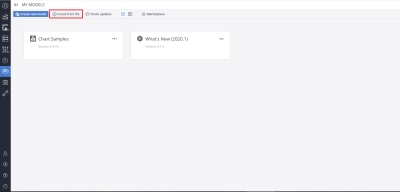
The rest of the Installation Wizard process is identical with the installation of a model from the Marketplace.
Notes:
- If you install a model from a file, you can upgrade it only from a file and not from the Marketplace. Also, models that are installed from the Marketplace, can only be upgraded from the Marketplace.
- When you cannot access Jedox Marketplace, please contact support to receive the model's file.
Create new model
You can use the Create new model button to build a new model.
You can choose a Namespace, a Fully qualified name, Name, Type, and Template for your new model. When naming your new model, do not use a special character, e.g., &. Also, note that changing an existing FQN (fully qualified name) is not allowed. FQN is used to connect the model to its reports, ETL projects, and other parts. Changing the FQN in the model properties disconnects it from its reports and ETL projects.
2. My Models start page
The My Models start page provides an overview of all models created or installed in your Jedox environment. The user can navigate to the reports of a specific model from My Models by clicking the arrow icon. Reports are also accessible by navigating directly to the Reports section of Jedox Web.
You can check for updates by clicking the Check for update button in the toolbar. Further options are available in the ellipses menu.
- Repair can be used if model contents have been inadvertently changed or deleted.
- Update (also in toolbar) is only available if there are changes to the model.
- Change installs / uninstalls selected parts of the model, such as sample data.
- Uninstall removes the local installation of the model, including reports, Integrator projects, settings, etc. Removal of database content is at the discretion of the model author; in the case of Jedox Models, database content is not deleted.
3. User Rights for Models
Access to the new My Models and Marketplace panels is handled via OLAP rights objects per role, and can be defined in Administration > Roles. Note that this only refers to the panels and action in those panels, but not access to model contents themselves, such as reports, databases, or Integrator projects. For My Models, the relevant right object is ste_packages. Users (or roles) with no access (N) are not able to see the My Models panel. User with Read access (R) are able to see the panel and the list of installed models. They are able to check for updates, but they are not able to install, uninstall, or modify models. Users with Write access (W) are additionally able to install, update and uninstall models.
The Marketplace is not visible to users who have no access (N) on the ste_repository right object. Users with Read access (R) are able to browse the Marketplace but cannot install any of the available models. Users with Write or Full access are able to install models from the Marketplace.
Note that if a model executes database scripts during installation, the user running the installation also must have all OLAP rights required for the commands in the scripts. This usually means that rights for creating database, dimensions, cubes, elements, rules etc. will be required.
4. Model Settings
In many cases, models will require some specific settings, such as a database name or connection name. In Administration>Settings, when creating a new settings key, you can select whether the key is “Global” or scoped within an existing model. Model-scoped settings are displayed in separate nodes in the navigation tree.
In Jedox Spreadsheets, model-scoped settings can be retrieved with the CONFIG.GET() function, which has an optional second parameter. In this parameter, you can specify a unique name of a model; the function will then try to retrieve the setting key specified in first parameter within the scope of the specified model. To retrieve the unique name of the model to which the current spreadsheet belongs, the new function MODEL.ID() can be used (the alias PKG.ID() also exists). For example, assume that your model includes a setting “logo_path” (containing an URL to some image). You could retrieve this setting value with: =CONFIG.GET("logo_path",MODEL.ID())
Updated November 4, 2024
